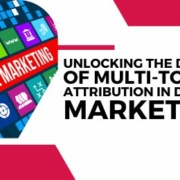Multi-Touch Attribution: Unraveling its Mechanism and Significance in Marketing
In the dynamic realm of marketing, the concept of Multi-Touch Attribution (MTA) has emerged as a pivotal technique for gauging the efficacy of strategies and comprehending the intricate customer journey. MTA operates under the assumption that every touchpoint a customer encounters throughout their journey wields influence over their ultimate decision to purchase a product or service. Although a relatively recent addition to marketing methodologies, MTA is rapidly gaining traction due to its capacity to offer profound insights into customer behavior and campaign effectiveness.
The fundamental premise of MTA revolves around acknowledging the existence of multiple touchpoints in a customer’s journey, each exerting varying degrees of influence on their decision-making process. The MTA model posits that from the initial awareness stage to the ultimate conversion, each touchpoint contributes significantly to the final purchase decision.

Exploring the Diverse Models of Multi-Touch Attribution
Several attribution models fall under the umbrella of Multi-Touch Attribution, each carrying its unique set of advantages and drawbacks. The linear attribution model, the most basic among them, assigns equal credit to every touchpoint along the customer journey, aiding in identifying effective marketing sources. However, it falls short in pinpointing the most valuable touchpoint in the journey.
The time decay attribution model, a popular alternative, assigns more weight to the latest touchpoints, assuming their increased value in the decision-making process while still recognizing the importance of each touchpoint.
The u-shaped attribution model adopts a different approach, giving the most credit to the first and last touchpoints and evenly distributing credit to the intermediate ones. While effective in identifying sources generating interest and demand, it may undervalue certain touchpoints.
The pinnacle of attribution models is the probabilistic multi-touch attribution, which scrutinizes thousands of unique buying journeys and millions of data points. This model determines the likelihood that a single touchpoint will influence a prospect’s decision to convert, dynamically adjusting marketing tactics based on changes in customer journeys.
Unlocking the Potential of Multi-Touch Attribution for Marketers
By leveraging Multi-Touch Attribution, marketers gain profound insights into the factors driving qualified leads to their products or services. Armed with this information, they can make data-driven decisions, allocating resources more judiciously in advertising endeavors. In the absence of a robust attribution model, marketers risk squandering resources on tactics that fail to generate leads for their company.
In essence, Multi-Touch Attribution stands as an invaluable tool for marketers, offering a deeper understanding of customer journeys and enabling optimization of marketing strategies for maximum efficacy. Through meticulous analysis of touchpoints, marketers can navigate the complex landscape of customer behavior and make informed decisions to propel their brands forward.
How does the Multi-Touch Attribution model view the customer journey, and why is each touchpoint significant?
The MTA model recognizes that a customer’s journey involves multiple touchpoints, with each exerting varying degrees of influence on the decision-making process. From initial awareness to conversion, every touchpoint significantly contributes to the final purchase decision, highlighting the importance of a comprehensive understanding of the entire journey.
What are the different models of Multi-Touch Attribution, and how do they differ in assigning credit to touchpoints?
There are several models, including the linear attribution model, time decay attribution model, u-shaped attribution model, and probabilistic multi-touch attribution. Each model has its unique approach to assigning credit to touchpoints, such as equal credit allocation, giving more weight to recent touchpoints, or distributing credit to the first and last touchpoints.
How does the probabilistic multi-touch attribution model set itself apart, and what benefits does it offer for marketers?
The probabilistic multi-touch attribution model stands out by evaluating thousands of unique buying journeys and millions of data points. It determines the likelihood that a single touchpoint influences a prospect’s decision to convert, providing dynamic adjustments to marketing tactics based on changes in customer journeys. This advanced model offers marketers unparalleled insights and adaptability.



















